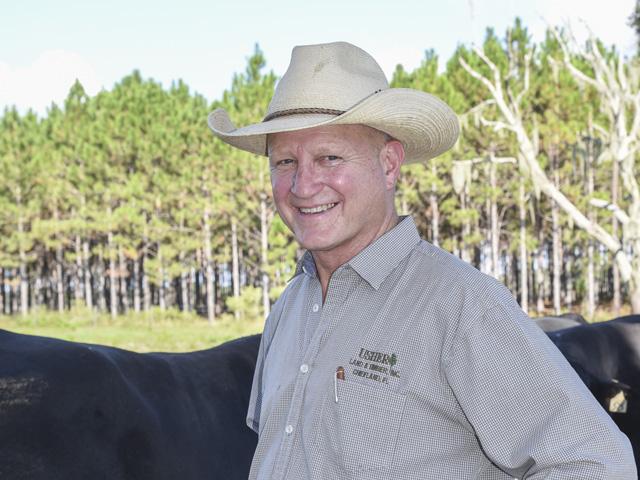Best Bull Depends on the Herd
Disposition and Maternal Traits Lead the Way in Selecting the Best Bull for Herd
It's hard not to get sticker shock when purebred bulls are going for $10,000 to $12,000 a pop. But get caught up in the excitement and competition of a bull sale, and you may suddenly find yourself way over budget.
How much should you pay for a bull for a commercial herd? Like most things in business, it depends. There are certainly some old-school rules of thumb, such as don't pay more than four times the price of 500-pound feeder calf. But Florida's Ken Griner doesn't give much weight to those formulas in his cattle operation.
"We can spend a little more than some commercial buyers because we retain ownership," he says. "We get paid for the quality we create. But we can't be frivolous and compete with seedstock breeders unless we are buying the bull for our seedstock herd."
Finding that perfect animal is something Griner really enjoys. He joined the family operation, Usher Land and Timber, some 30 years ago. Once bull buying became one of his responsibilities, he says he's been trying to build the perfect animal for this hot, humid environment.
SETTING THE PARAMETERS
Maternal characteristics are key in the heifers the Chiefland operation produces. Bulls here need strong genetics for calving ease and fertility, a moderate frame, good structure, an above-average scrotal circumference, (an indicator of age of puberty in the heifers sired by a bull), marbling, rib-eye size, and disposition.
P[L1] D[0x0] M[300x250] OOP[F] ADUNIT[] T[]
"You have to have disposition," Griner stresses. "We have bred for this so long, sometimes at processing you have to get off your horse to move the calves, or otherwise they'll just stand there and look at you."
Disposition is the trait University of Nebraska Extension Beef Genetics specialist Matthew Spangler likes to start with when evaluating bulls. Along with that, he says it's important to consider how an operation markets as well as how much better genetically one bull is than the others in a sale.
As a practical matter, he says, producers should consider how many cows will be exposed to the bull and take that into their calculations, as well.
"You can pay more if you can spread him out over more cows," he explains. "If you have 20 cows, you can't afford to spend as much as someone who can expose him to more than 20 cows. And if you can get him custom collected, use him as an AI (artificial insemination) sire, and also as a natural service sire, you can pay more, because you're able to spread the cost over more cows."
SELECTION PROCESS, BREEDER LOYALTY
In Griner's case, he, his son, Korey, and long-time friend R.D. Skelton, each go over sales catalogs. They start by choosing the seedstock supplier they want to buy from. Exact EPDs they require on a bull are determined by whether the sire will be used on replacement heifers, in their terminal cross herd or in their composite operation. They look for bulls well above average for their respective breeds.
"We can't buy average bulls and grow the kind of calves we need," says Griner, adding that after they narrow their selections, whoever goes to the sale gives those bulls the once over. "They have to pass the eye test, too," he says.
Next comes the hard part. The person attending the sale takes a seat in the stands and tries to practice patience.
"Most of the time, you can be patient and some of the good bulls will fall through the cracks. If you don't actually go to the sale, you can't do that," Griner says. He points to a yearling Angus bull in a catalog that got a thumbs up from both Ken and Korey. It came from a cow family they favored, and it passed the eye test. The young bull was a bit lower down in the sale order. While Griner expected to pay at least $5,000 to $6,000 for him, Korey was able to seal the deal at $4,000.
BREEDER LOYALTY
For the Charolais bulls that go into their composite breeds, as well as Angus bulls for their heifers, Griner relies on a Kansas breeder. "He eliminates the opportunity for me to make mistakes," he says. "He takes care of legs, udder, structure, and then I don't have to worry about them."
An Angus breeder in South Carolina supplies bulls for clean-up duty after replacement heifers are AIed. "They like what we like," Griner notes. "Good, proven genetics from proven cow families, moderate framed cattle. They work."
Travis Mitchell, Clemson University area livestock and forages agent, says when he's buying bulls for his own 200-cow commercial herd, he too places a lot of value on the seedstock producer.
"My seedstock supplier works tirelessly for their customers, and the sale doesn't stop when the bull leaves their farm," he adds. "They stand behind the bulls and help find ways to market the offspring from their genetics. That counts for a lot."
(c) Copyright 2022 DTN, LLC. All rights reserved.






